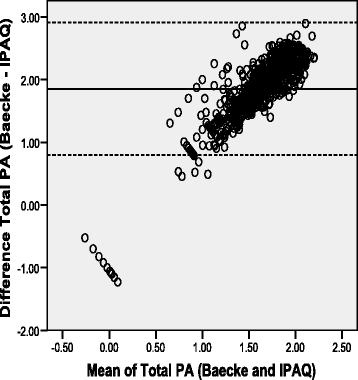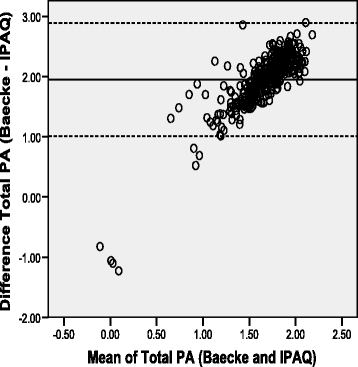Measurement of physical activity in urban and rural South African adults: a comparison of two self-report methods
- PMID: 27658580
- PMCID: PMC5034669
- DOI: 10.1186/s12889-016-3693-6
Measurement of physical activity in urban and rural South African adults: a comparison of two self-report methods
Abstract
Background: Due to the large mortality from inactivity-related non-communicable diseases in low- and middle- income countries, accurate assessment of physical activity is important for surveillance, monitoring and understanding of physical (in)activity epidemiology in many of these countries. Research on relative performance of self-report physical activity instruments commonly used for epidemiological research in Africa have rarely been reported. The present study compared estimates of physical activity measured with the International Physical Activity Questionnaire - Short Form (IPAQ-SF) and the Baecke Physical Activity Questionnaire (BPAQ) among urban and rural black South African adults.
Methods: Self-reported physical activity data using the IPAQ-SF and BPAQ were collected from a representative sample of 910 urban and rural black South African adults (age = 59.2 ± 9.5 years, 69.7 % women) participating in the 2015 wave of the Prospective Urban and Rural Epidemiological (PURE) study in the North West Province of South Africa. Between-method relationships (pearson correlations [r] and intraclass correlation coefficients [ICCs]) and agreements (Bland-Altman mean difference with 95 % limits of agreement and Kappa coefficient [k]) of IPAQ-SF and BPAQ variables were estimated. Sensitivity and specificity of the BPAQ relative to the IPAQ-SF to classify individuals according to the international guidelines for sufficient physical activity were calculated using chi-square statistics.
Results: Correlations between IPAQ-SF scores and BPAQ indices were small (r = 0.08-0.18; ICCs = 0.09-0.18) for BPAQ leisure and sport indices, moderate-to-large for work index (r = 0.42-0.59; ICCs = 0.40-0.62) and total physical activity index (r = 0.52-0.60; ICCs = 0.36-0.51). Between methods mean difference for total physical activity was large (1.85 unit), and agreement in physical activity classifications was poor to moderate (k = 0.16-0.44). The sensitivity of the BPAQ to identify sufficiently active people from the IPAQ-SF was very good (98 %), but its specificity to correctly classify insufficiently active people was weak (23 %).
Conclusion: Notable disparities in physical activity estimates between methods suggest that utilization of IPAQ-SF and BPAQ for surveillance and epidemiology studies in Africa should depend on research questions and population to be studied. Future studies with objective measures are needed to confirm the relative validity between the two instruments.
Keywords: Baecke physical activity questionnaire; Epidemiology; International physical activity questionnaire; Low-and middle-income countries; Public health guidelines; Surveillance.
Figures



Similar articles
-
Accelerometer-determined physical activity and its comparison with the International Physical Activity Questionnaire in a sample of Nigerian adults.PLoS One. 2014 Jan 28;9(1):e87233. doi: 10.1371/journal.pone.0087233. eCollection 2014. PLoS One. 2014. PMID: 24489876 Free PMC article.
-
Validity and reliability of an adapted arabic version of the long international physical activity questionnaire.BMC Public Health. 2017 Jul 24;18(1):49. doi: 10.1186/s12889-017-4599-7. BMC Public Health. 2017. PMID: 28738790 Free PMC article.
-
Criterion validity of The International Physical Activity Questionnaire-Short Form (IPAQ-SF) for use in clinical practice in patients with osteoarthritis.BMC Musculoskelet Disord. 2021 Feb 27;22(1):232. doi: 10.1186/s12891-021-04069-z. BMC Musculoskelet Disord. 2021. PMID: 33639913 Free PMC article.
-
Reliability and validity of two multidimensional self-reported physical activity questionnaires in people with chronic low back pain.Musculoskelet Sci Pract. 2017 Feb;27:65-70. doi: 10.1016/j.msksp.2016.12.014. Epub 2016 Dec 26. Musculoskelet Sci Pract. 2017. PMID: 28637603
-
Test-retest reliability, agreement and construct validity of the International Physical Activity Questionnaire short-form (IPAQ-sf) in people with COPD.Respir Med. 2023 Jan;206:107087. doi: 10.1016/j.rmed.2022.107087. Epub 2022 Dec 7. Respir Med. 2023. PMID: 36525854
Cited by
-
Feasibility and acceptability of a contextualized physical activity and diet intervention for the control of hypertension in adults from a rural subdistrict: a study protocol (HYPHEN).Pilot Feasibility Stud. 2024 Feb 3;10(1):22. doi: 10.1186/s40814-024-01456-w. Pilot Feasibility Stud. 2024. PMID: 38308346 Free PMC article.
-
Health and Nutrition Analysis in Older Adults in San José de Minas Rural Parish in Quito, Ecuador.Glob Health Epidemiol Genom. 2023 Feb 13;2023:1839084. doi: 10.1155/2023/1839084. eCollection 2023. Glob Health Epidemiol Genom. 2023. PMID: 36814561 Free PMC article.
-
Depression's double-edged impact on body mass index. A hidden catalyst for non-communicable diseases in South Africa's aging population in long-term care facilities.PLoS One. 2025 Feb 13;20(2):e0319188. doi: 10.1371/journal.pone.0319188. eCollection 2025. PLoS One. 2025. PMID: 39946381 Free PMC article.
-
Dose-response association between physical activity and clustering of modifiable cardiovascular risk factors among 26,093 Chinese adults.BMC Cardiovasc Disord. 2020 Jul 25;20(1):347. doi: 10.1186/s12872-020-01627-6. BMC Cardiovasc Disord. 2020. PMID: 32711476 Free PMC article.
-
Nutrient Patterns Associated with Fasting Glucose and Glycated Haemoglobin Levels in a Black South African Population.Nutrients. 2017 Jan 19;9(1):9. doi: 10.3390/nu9010009. Nutrients. 2017. PMID: 28106816 Free PMC article.
References
-
- World Health Organization . Global status report on noncommunicable diseases 2014. Geneva: WHO; 2015. - PubMed
LinkOut - more resources
Full Text Sources
Other Literature Sources

